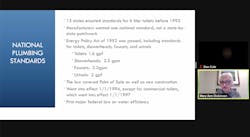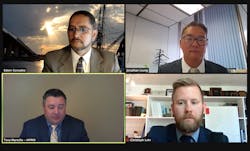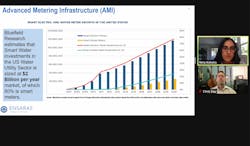Latest from Industry Event News
Sponsored
On May 11th and 12th, some of the top innovators, researchers and experts in the water industry met virtually for the seventh biennial Emerging Water Technologies Symposium.
The co-conveners are a Who’s Who of the top industry associations: The International Association of Plumbing and Mechanical Officials (IAPMO), Plumbing Manufacturers International (PMI), The World Plumbing Council (WPC), The Alliance for Water Efficiency (AWE), and The American Society of Plumbing Engineers (ASPE). Industry partners of the symposium included The Mechanical Contractors Association of America (MCAA), The Plumbing Heating Cooling Contractors National Association (PHCC), The American Supply Association (ASA), The Canadian Institute of Plumbing and Heating (CIPH), and The United Association (UA).
The mission of the symposium is to allow participants to discover new technologies that are coming to market, to learn about innovative green plumbing and mechanical concepts, and to engage in timely discussions on how the water utility, manufacturing, engineering and trade industries have found solutions to improve water efficiency.
Opening Welcome
The symposium opened with a welcome from Tony Marcello, Sr. VP of Training and Credential Services at IAPMO who welcomed attendees and thanked the sponsors and media partners who had helped make the event possible.
This particular EWTS was a special one for Viola, he noted, as it was his first as CEO of IAPMO, following the retirement of Russ Chaney.
Billy Smith, Executive Director/CEO of ASPE gave his welcome, and spoke briefly how the symposium’s opportunities for collaboration fit well with ASPE’s mission. “Our need to demonstrate stewardship of our world’s water supply has never been more urgent,” Smith said.
Next to virtual podium was Kerry Stackpole, CEO of PMI, who noted that it was an exciting time to be in the plumbing industry. Stackpole pointed out that plumbers have been singled out as essential workers from the earliest days of the pandemic, and that throughout the crisis, demand for plumbing products and innovations has remained high. “What we do matters,” Stackpole said, “what we do is more consequential to human existence than most of us realize.”
Stackpole then introduced the “rookie” of the group, the new CEO of AWE, Ron Burke, who was attending his first EWTS. Burke said he was glad to be a participant and looking forward to the many conversations to come. The work of the persons and organizations gathered together for the symposium was more important than ever, Burke said, especially in the light of current and future water crises happening around the globe. Crises, he said, which global climate change would only make more profound in the coming years.
The Fight Over Standards
Burke then introduced Mary Ann Dickinson, noting that she would presently assume the title of Past President and CEO of AWE upon her retirement. In her opening presentation, The Drama Over US Water Efficiency Standards, Dickinson said that an awareness of US regulatory policy was important for everyone in the industry, especially in light of various attempts to erode those standards. “You need to know where you, as a plumber, stand,” Dickinson said.
The Trump Administration later tried a few “end-runs” around Congress, such as attempting to re-define what showerheads were, and creating a new product class for clothes washers and dishwashers. While AWE did what it could to oppose those changes (including filing suit), those rules have gone into effect under the new administration.
Dickinson touted the success of the WaterSense program, which, while authorized by Congress in 2018 is still not a budget line item (it is instead funded through the EPA). Given the proven success of the program (anywhere from $2.5 to $2.8 billion back for every $1 billion spent on water efficiency) it’s regrettable, Dickinson said, that it doesn’t see the same sort of support as the Energy Star program. Right now, spending on energy efficiency outpaces spending on water efficiency by 134:1.
As another example of how energy efficiency seems to get preferential treatment over water efficiency, energy rebates are tax exempt, while water rebates aren’t. Hopefully, said, Dickinson, with the present Congress that could change.
Burke then thanked Dickinson, both for her presentation and her many years of service with the AWE.
Designing for Resilience
Other sessions the first day included Environmental Monitoring for Assessing Risk From Legionella by Dr. Janet E. Stout, President and Dir. of Special Pathogens Laboratory, and research associate professor at the University of Pittsburgh Swanson School of Engineering, and Moving Towards Predicting Building Water Safety by Andrew J. Whelton, Assistant Professor, Civil & Environmental Engineering, Purdue University.
Lohr started the discussion by addressing building awareness. All water, he pointed out, is recycled in some way or another, and sometimes it works better to have a centralized treatment plant, and sometimes it makes more sense to have it all done inside a single building. System design becomes a kind of balancing act between safety, disaster mitigation and affordability/equity.
Leung then gave a brief introduction to his work at the LA Dept. of Water and Power, saying that he keeps three things in mind as he goes about his job: clean water is a basic human need, sustainability, and effective partnerships. He then talked a bit about the convergence of conservation (designing and planning to manage demands and shortages) and resiliency (designing and planning for natural disasters such as firestorms, earthquakes, hurricane, freezing, power outages, drought and more).
Leung said that while no one hand answers to all the problems communities faced, the LADWP had come up with some innovative ideas, such as:
· Shade balls to enhance surface water quality
· Pipe flushing equipment that recaptures water that would otherwise be wasted
· Online water quality monitoring
He also stressed that no one can do it alone. A comprehensive plan needs to include outreach and education to customers and plumbing officials, training to make sure people doing the work of water quality treatment have the necessary skills, and fostering innovation in design and materials.
Gonzalez pointed out that resilience, at its most basic level, is about recovering from misfortune or change. To that end, water system automation can provide huge advantages at four separate stages: risk assessment, prevention, monitoring, and intervention.
All automation requires dynamic, data-driven, documentable control. Smart systems that can deliver that kind of control are now becoming more prevalent in all aspects of our lives. Key factors to control for are temperature, flow, usage and water age (the last being particularly important in fighting waterborne pathogens). Key tools to help achieve that level of control include digital mixing valves, smart balancing valves, specialized fittings/fixtures, and the new generation of leak detection devices.
The panel then opened up to a Q&A. Some topics included changes to the plumbing code, how to fund steps to address resilience in water systems, and how insurance companies are helping to drive investment in more resilient systems.
Research and Implementation
The second day of EWTS began with a presentation from Nina Kshetry, the founder and president of Ensaras, Inc., a company specializing in advanced analytics and artificial intelligence solutions. The Internet of Water: Enabling Competitions to Drive Behavioral Change was a discussion on the value to be found in Big Data. Today in the water industry, huge amounts of data are coming from leak detection devices and AMI (Advanced Metering Infrastructure).
Later, Steven G. Buchberger, professor of Civil and Environmental Engineering at the University of Cincinnati presented The Water Demand Calculator Leaves Home. His talk presented some of the findings from a six-year IAPMO study on estimating peak water demands in residential buildings fitted with efficient fixtures.
Chris Kay, the COO of Water Harvesting, Inc., gave his talk, Water from Air, that discussed the evolution of water-from-air technology. Dr. William Healy, Leader of the Heat Transfer & Alternative Energy System Group at NIST gave a presentation, Identifying Key Research Needs for Premise Plumbing.
Healy’s report dovetailed with the symposium’s concluding panel discussion, Premise Plumbing Research and Implementation—What’s Next?, with Dr. Healy and Buchberger joined by Andrew K. Persily, Chief of the Energy and Environment Division at NIST, Dr. Grace Jang, Research Program Manager at the Water Research Foundation, Regan Murray, Director, Water Infrastructure Division, EPA, and Dan Cole, Sr. Director of Technical Services, IAPMO.
Three key topics for the panel included trends impacting premise plumbing systems, the most critical research needs, and facilitating implementation—all the research in the world won’t do any good if it isn’t at some point put into action.
Jang discussed how the Water Research Foundation had funded projects to address fundamental questions of forecasting and management. How, she asked, can water utilities better communicate their problems? What are the advantages and limitations of combined pathogen mitigation methods? The complexity of the problems we face, Jang said, requires better science. Good science, she concluded, leads to better policy.
Buchberger discussed the IAPMO study of Hunter’s Curve and its implications. The Water Demand Calculator was a powerful tool, he said, but it still only gives a snapshot of a single moment in time. We have the technology (or we soon will) to go from a static picture to a dynamic view. “We are at the dawn of a new age,” Buchberger said, “all we have to do is put the tools together.”
Cole talked about how far codes and standards have come since the days Roy Hunter was gathering his data. We need better science behind our code provisions, he said. Too many provisions are coming in without being tested.
We also need better information on water supply flow and the quality of water. What kind of flow conditions are we actually seeing? Some of the data we currently have, he said, is counter-intuitive. You would expect turbulent systems to disturb/decrease the biofilm, but this is not neccssarily the case.
Healy felt that a more holistic approach to building design is needed; one that includes water energy—everything.
Christoph Lohr then moderated a wide-ranging discussion that concluded with thanks to both the panelists and attendees.
Steve Spaulding | Editor-inChief - CONTRACTOR
Steve Spaulding is Editor-in-Chief for CONTRACTOR Magazine. He has been with the magazine since 1996, and has contributed to Radiant Living, NATE Magazine, and other Endeavor Media properties.







